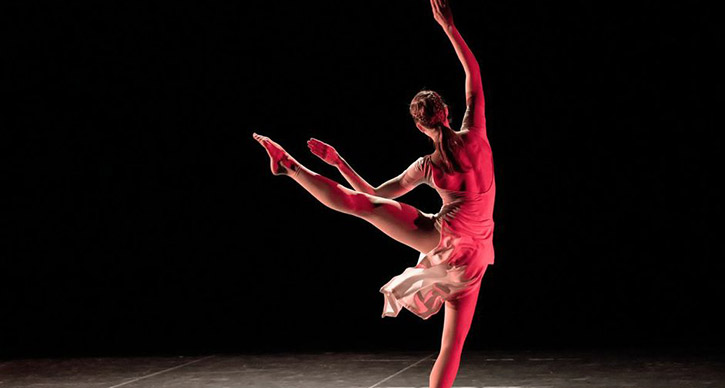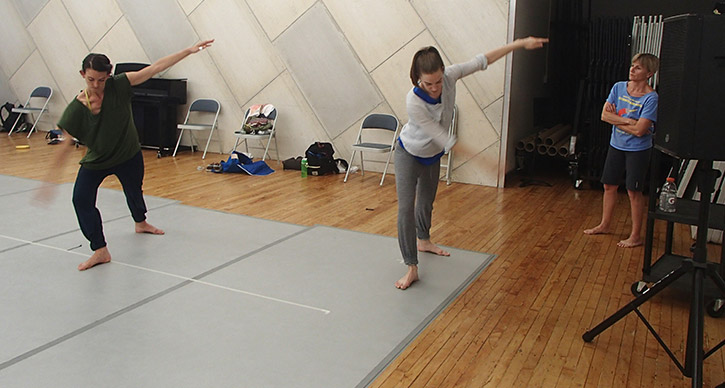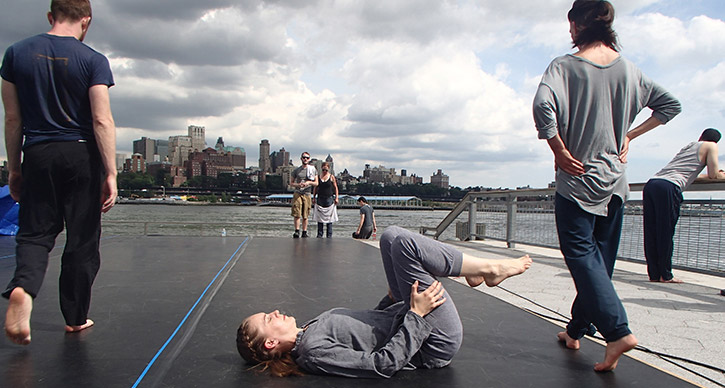Artist Interview: Jamie Scott, Trisha Brown Dance Company Dancer

Photo: Trisha Brown Dance Company dancer Jamie Scott performs “If You Couldn’t See Me.” Photo by Alice Gebura.
The Trisha Brown Dance Company performs in Ann Arbor on February 21-22, 2015. Hillary Kooistra, University of Michigan Dance student and UMS intern, spent five weeks with the company during Summer 2014 as part of a new internship program. During her internship, Hillary had the chance to work with the company, and also to sit down with company members and interview them.
Her first was with dancer Jamie Scott. Jamie started dancing with the company as an apprentice in February 2012.
Hillary Kooistra: You’ve actually performed at UMS before with the iconic Merce Cunningham Dance Company. How has your work with the Trisha Brown Dance Company (TBDC) compared to your experience with Merce Cunningham?
Jamie Scott: It’s a very different way of approaching movement for me. A lot of the work that I’ve been doing since I joined TBDC has been re-calibrating the way that I think about movement, the way that I see movement, and the values that I give to different types of movement. There are many similarities, too, with learning repertory that’s been done before and with finding a way to re-inhabit works that have been done.
HK: Aesthetically, what would you say are some of the differences between Trisha’s work and Merce’s work?
JS: They strike a very similar aesthetic or taste from my point of view. But I’d say the biggest difference is that Merce’s work is very externally driven. The movement is very inorganic, and the task is finding a way to do the impossible, to use your muscles and everything you have to make these tasks possible. With Trisha, it’s almost the opposite. There are equally impossible tasks, but I’m trying to strip away as much as I can and re-calibrate force and energy. To find a way to arrive at the impossible form the inside out, rather than the outside in.

Photo: Jamie and Cecily Campbell (who shares the soloist role in “If You Couldn’t See Me”) rehearse part of the solo with Associate Artistic Director Diane Madden. Photo by Hillary Kooistra.
HK: At Power Center, you’ll perform Trisha Brown’s solo “If You Couldn’t See Me.” I know that you didn’t get to work directly with Trisha Brown in the studio, so how did you prepare, learn, and embody her movement for this solo?
JS: Leah Morrison, another dancer who has performed this solo, taught it to me along with Carolyn Lucas, one of the associate artistic directors of the company. After Leah left the company, we sat down with this amazing archive of footage of Trisha when she was first making the solo. In the video, she is going through the process of creating the movement, just so, and then taking it a step further, and then paring it back. We kind of went along with her whole process, and in doing that we got a lot of physical information that then translated into what you’ll see on the stage.
HK: I’ve noticed that the company often rehearses without music. When you do put on the music, what is that extra layer like?
JS: Actually, working with Merce Cunningham was similar in that respect. We never rehearsed to music, so I’ve gotten used to that. It’s sort of on and off, on and off. But I remember that the first time that I performed to music after rehearsing in silence, it added another dimension in the space. It opened up my awareness, my perception of the space, and gave me something else to interact with. Very tangible, actually. Oddly enough, it seemed very tangible.

Photo: Jamie warms up before the Company’s performance of “I’m Going to Toss my Arms–If You Catch Them They’re Yours” at Pier 15 for the 2014 River To River Festival in New York City. Photo by Hillary Kooistra.
HK: What would you say is the most challenging aspect of Trisha Brown’s work?
JS: I would say that it’s being honest with movement and not embellishing, not exaggerating, but trusting the simplicity of it.
HK: Trisha’s known as one of the most iconic post-modern dancers and choreographers of our time, partially because of that quality of her movement vocabulary. Do you think that this term “post-modern” accurately characterizes her work?
JS: If we’re talking about stripping away the fluff, which is one of the big tenets of post-modernism in dance, really getting back to the human and getting rid of the fluff, this work continues to do that. This work is all about that, especially the earlier programs. The later work begins to explore, and as with any great artist, the trajectory goes somewhere else.
Read more of Hillary Kooistra’s behind-the-scenes coverage of Trisha Brown Dance Company.
Merce Cunningham Dance Company in Ann Arbor (Recap)
For those who enjoyed the Merce Cunningham Dance Company’s final UMS appearance in February, don’t miss this recap of all the residency activities the company participated in while they were in Ann Arbor.
Does where you sit affect how you feel about a performance?
Earlier this month, the New York Times published a really interesting series of articles that tackled the question, “does where you sit affect how you feel about the performance?” In the series, four NYT dance critics give their take on different views of a City Ballet performance in New York City’s David H. Koch Theater: the chief critic Alastair Macaulay in the first ring, critics Roslyn Sulcas and Gia Kourlas in orchestra, and Ms. LaRocco from her view three rows from the very top of the theater. (Check out the NYT series here: parts one, two, and three.)
The UMS Student Board was inspired to take a similar look at the views from Ann Arbor’s Power Center, using the February 18th & 19th Merce Cunningham Dance Company performances as their lens: Cathy Cao near orchestra, Rheme Sloan in center balcony, and Lena Cintron on the main floor. Read on for a snapshot of the view from their seats and tell us: where do you prefer to sit?
 CATHY CAO: I was very happy to see the seat on my ticket (section 5 row Q, seat 10), because I always love sitting at the partial view seats along the sides of the orchestra section. It excites me to see into the wings, and watch as dancers prepare before their entrance onto stage. Once on stage, a dancer has a projected presence of playing a part or a role, however seeing them backstage feels intimate. It feels like I am sharing in that private moment with the dancer, as she/he is about to burst onto stage; I am sharing in that moment of held breathe, of anticipation and excitement, of passage from a regular person to the character she/he is about to dance on stage. Cunningham’s “Squaregame” is the perfect example, since all the curtain dividers were raised. The dancer’s behind-the-stage-activities were all fully exposed to me as were the brick walls, folded sets, and extra equipment scattered haphazardly that were usually hidden behind the velvet black divider. I was more than willing to give up my vision of a small corner of the stage when I was able to share in so much more.
CATHY CAO: I was very happy to see the seat on my ticket (section 5 row Q, seat 10), because I always love sitting at the partial view seats along the sides of the orchestra section. It excites me to see into the wings, and watch as dancers prepare before their entrance onto stage. Once on stage, a dancer has a projected presence of playing a part or a role, however seeing them backstage feels intimate. It feels like I am sharing in that private moment with the dancer, as she/he is about to burst onto stage; I am sharing in that moment of held breathe, of anticipation and excitement, of passage from a regular person to the character she/he is about to dance on stage. Cunningham’s “Squaregame” is the perfect example, since all the curtain dividers were raised. The dancer’s behind-the-stage-activities were all fully exposed to me as were the brick walls, folded sets, and extra equipment scattered haphazardly that were usually hidden behind the velvet black divider. I was more than willing to give up my vision of a small corner of the stage when I was able to share in so much more.
Cathy Cao is a Junior at University of Michigan’s Residental College, studying Dance History and Cultural and Community Development. In her free time she likes to see as much dance as possible and practice some herself.
 RHEME SLOAN: I watched Friday’s Performance of the Merce Cunningham Dance Company from the center section in the balcony. In “Squaregame” I could see the shapes in the choreography. The spatial setting that Cunningham created was clearly defined because each corner of the dance floor was visible from my seat. I thought that the cross floor patters the dancers executed were clear and precise throughout. Having such a clear view of the entire stage was a great advantage to enjoying this piece.
RHEME SLOAN: I watched Friday’s Performance of the Merce Cunningham Dance Company from the center section in the balcony. In “Squaregame” I could see the shapes in the choreography. The spatial setting that Cunningham created was clearly defined because each corner of the dance floor was visible from my seat. I thought that the cross floor patters the dancers executed were clear and precise throughout. Having such a clear view of the entire stage was a great advantage to enjoying this piece.
“Split Sides” was also wonderful based on the fact that I could see all that was happening on stage. Although I couldn’t see the tops of the backdrops, the view of the dancers was incomparable. Especially in ensemble work like Cunningham’s, balcony seats are the definite way to go.
Rheme Sloan is a first year Voice Performance student in the School of Music, Theater, and Dance. Although he is studying voice, he loves experiencing all performing arts and culture.
 LENA CINTRON: I was in the middle of the second row and the view was spectacular. I could literally see the sweat dripping from the dancers and watch their breathing. In “Squaregame,” when the stage was stripped bare, I could see the dancers in the wings stretching and preparing to come to the middle of the stage. This seat was ideal, no movement was missed. In the second half, when the curtains were up again, dancers seemed to float onstage from nowhere and float away just as easily. For both dances I felt like I was seeing exactly what I was supposed to and missing anything that subtracted from the power of the dance.
LENA CINTRON: I was in the middle of the second row and the view was spectacular. I could literally see the sweat dripping from the dancers and watch their breathing. In “Squaregame,” when the stage was stripped bare, I could see the dancers in the wings stretching and preparing to come to the middle of the stage. This seat was ideal, no movement was missed. In the second half, when the curtains were up again, dancers seemed to float onstage from nowhere and float away just as easily. For both dances I felt like I was seeing exactly what I was supposed to and missing anything that subtracted from the power of the dance.
Lena Cintron is a student at the University of Michigan studying Linguistic Anthropology and Creative Writing. Her favorite thing about Ann Arbor is the access to great performing artists.
So tell us, where do you like to sit?
A Dancer’s Life After Merce
Editor’s Note: Before he passed away, choreographer Merce Cunningham began planning for the future of his company without him. He decided that, upon his death, or at a suitable time thereafter, the Merce Cunningham Dance Company (MCDC) would embark on one final 2-year Legacy Tour and then dissolve. You can read more about his Legacy Plan here. Silas Riener, a dancer with MCDC, shares some reflections from his time with Merce and the company, and tells us a little bit about what life looks like for him after this final tour comes to a close.
 Ann Arbor marks the beginning of the 3rd week of this part of the tour, full of winter weather (Iowa, rural Pennsylvania, minus seven degrees at times…) and lots of good times. We have been performing lots of different rep, notably BIPED, which has only been seen once before on the Legacy Tour, and a few Soundance’s, which is always really nice for the company. Ann Arbor will see Split Sides and Squaregame, two of our more high energy pieces, which we have been looking forward to getting back into.
Ann Arbor marks the beginning of the 3rd week of this part of the tour, full of winter weather (Iowa, rural Pennsylvania, minus seven degrees at times…) and lots of good times. We have been performing lots of different rep, notably BIPED, which has only been seen once before on the Legacy Tour, and a few Soundance’s, which is always really nice for the company. Ann Arbor will see Split Sides and Squaregame, two of our more high energy pieces, which we have been looking forward to getting back into.
It has been interesting touring Merce’s work since he died. I feel like for many of us his presence was vital to our experience, and his input was crucial to our understanding of the material. Sometimes even his lack of input would be just as important; I learned so much from what Merce would say, or what he wouldn’t say. He was guiding our experiences, and in his absence, we have been forced to find governing principles for ourselves. Sometimes it seems easier than others; the vacuum persists.
Much thought and discussion has gone into planning the future once the company closes. For many of us dancers in the company, working for Merce was all we were ever interested in doing. It was a goal to be reached, and it certainly wasn’t easy. It’s strange to imagine other possible paths when the thing you have been trying for so long to get, you already have. It has made many of us reconsider our values and whether we are interested in continuing to dance or maybe more interested in doing something else.
For myself, I know that I still have a really strong interest in continuing to dance. I have been with MCDC for three and a half years now, and it has been a wonderful experience, but I have begun to feel the lack of my own creative voice. It has been hard since Merce died, that all the new work the company has taken in is revival. I can’t fully impart the sort of ecstatic paradigm shift that came when Merce was making a new piece, and I only really got to experience it once (Nearly Ninety). It was as if the steps were coming out of the air, and even if it was a familiar one, as it often was, say a triplet, it still felt special because you knew that no one had yet done a triplet THIS way. The revivals are wonderful, but it’s a different experience learning from video, or knowing that you are re-interpreting steps made for someone else.
It’s for this reason that I have begun to think about making work myself. Along with another dancer in the company, Rashaun Mitchell, I have begun creating dance projects, and we have put some showings together. It’s difficult to find rehearsal time inside the busy Cunningham touring schedule, but it’s been liberating at the same time. We are able to set our own schedule, and we are able to think of ourselves as makers with a real will to create something that maybe hasn’t been seen before.
Our first project together, a collaboration with poet Anne Carson ( a sometime Ann Arbor resident) was first shown last summer, both at Mount Tremper Arts Festival in New York, and at Boston’s ICA Co-LAB. Here in Ann Arbor, we’re taking some time to revamp a few sections of the dance, which takes Carson’s new book Nox as its subject. We’ll be showing a bit of it Thursday, February 24 at 3:10pm in Studio A of the U-M Dance Building if anyone is interested. An excerpt of the Boston performance can be seen below.
Hope you have enjoyed this bit of insight into the company life, and I hope you come to the show! Friday and Saturday, February 18-19 at the Power Center.
Free Public Events with the Merce Cunningham Dance Co. This Week
Each year, we have a chance to get to know some of the artists on the UMS season a little better. We hope you’ll join us this week for any of the free public residency events with the Merce Cunningham Dance Company:
Evolution of a Brand: Merce Cunningham Dance Company
TONIGHT! Mon, Feb 14, 5 pm
U-M Ross School of Business R1220 (701 Tappan)
MCDC Executive Director Trevor Carlson leads a discussion with UM business school students on the development, maturation, and end of a well-known brand; the legacy of the company’s identity and how the brand will live on; and what we can learn from this process about problem-solving and leadership.
A collaboration with Ross Leadership Initiative
A Lifetime of Creativity: Merce Cunningham and Defying Limitations
Wed, Feb 16, 6 pm
Helmut Stern Auditorium, UMMA (525 S. State St.)
Panel discussion on the changes in creative process throughout the life of an artist with Trevor Carlson, MCDC Executive Director; David Vaughn, MCDC Archivist; Christine Bratton, MCDC Physical Therapist; UM Professor Nicholas Delbanco who tackles the enigma of “Lastingness” over a creative life in his new book of the same title; and Professor Joel Howell, MD who will address the physical changes inherent in the aging process.
A collaboration with UMMA, U-M Department of English Language & Literature, and the U-M Health System
A Lifetime of Inspiration: U-M Dance Student Responses to Merce’s Story
Thu, Feb 17, 7 pm
Betty Pease Dance Studio A (1310 N. University Ct.)
U-M Dance Students create solo work in response to Merce Cunningham’s “A Lifetime of Dance” film, and perform works for current company members. Current company members then each tell a story about their performing life with Merce.
A collaboration with U-M School of Music, Theatre & Dance
“Dance by Chance” Audience Warm-Up
Fri-Sat, Feb 18-19, 7 pm
U-M Alumni Center
Free pre-performance warm-up, open to MCDC ticket-holders. Learn about Merce Cunningham’s choreographic process, and how he used “chance operations” in his work. Then try the process yourself in a pre-performance chance operations warm-up for the audience facilitated by MCDC Company Manager Kevin Taylor.
Post-Performance Q & A:
Merce Cunningham Dance Company
Friday, February 18
Power Center
Members of the Merce Cunnigham Dance Company discuss their performance and take questions from the audience. Must have a ticket to attend.



